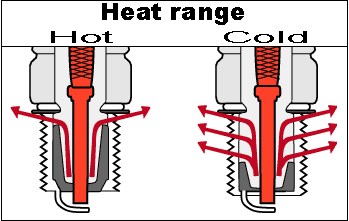It is important to understand that a spark plug heat range has no relationship to the electrical energy transferred through the spark plug, the strength, duration of the spark will be the same for every heat range. The heat range of a spark plug is simply the range in which the plug works well thermally.
The heat rating of each plug is indicated by a number; for NGK, Denso and Champion lower numbers indicate a hotter type, higher numbers indicate a colder type. With other brands such as Bosch and Autolite lower numbers are colder and higher numbers are hotter. It is important to note that there is no standard when changing brands.
When a spark plug is referred to as a “cold plug”, it is one that transfers heat rapidly from the firing tip into the engine head, keeping the firing tip cooler. A “hot plug” has a much slower rate of heat transfer, which keeps the firing tip hotter. Tip temperature is related to the length of the ceramic insulator. Long insulator tips have a longer heat transfer path than short insulator plugs.

In operation the spark plug firing end temperature must be kept low enough to prevent pre-ignition, but high enough to burn off deposits and prevent fouling. This is called “thermal performance,” and is determined by the heat range selected.
The use of an incorrect heat range plug can severely damage an engine so unless you are an experienced engine tuner it is always best to stick with the factory recommended heat range.
If you are experiencing fouling issues you should correct the underlying jetting problem that is causing them rather than risk engine damage by changing the spark plug heat range.


